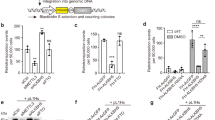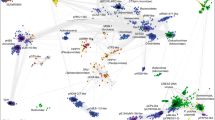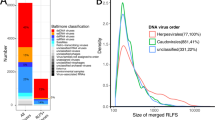Abstract
Primate and rodent genomes contain a family of highly repetitive, long interspersed sequences, designated the L1 family or LINE-1 (refs 1–4). Characteristic features of the L1 family sequences such as an A-rich stretch at the 3′ end, a truncated 5′ end, the existence of significantly long open reading frames (ORFs)5–9 and the presence of L1 family transcripts in various types of cells, including pluripotential embryonic cells10–15, suggest that the L1 family is derived from a sequence encoding a protein(s) and dispersed in the genome through an RNA-mediated process. These features of the L1 family are believed to be due to reverse transcription beginning at the 3′ end of the L1 transcript and terminating prematurely and to the site duplication caused by the insertion of the complementary DNA (reviewed in refs 3, 4). It is likely that this type of transcript is converted to cDNA and inserted into the chromosome through a process similar to that of the formation of processed pseudogenes16. The above model, however, does not necessarily explain why the L1 family should produce the extraordinarily large number of copies (more than 104 per haploid genome17) seen during evolution. It seems likely that the progenitor of the L1 family itself carries (or carried) a function which promotes the active dispersion of the L1 family sequence. We reasoned that such a function, if present, must be conserved during evolution and may be shown by comparative analysis of L1 family sequences from evolutionary distant species. We show here that the L1 family sequence contains an ORF possessing significant sequence homology to several RNA-dependent DNA polymerases of viral and transposable element origins. This provides a plausible explanation for the preferential and active dispersion of the L1 family sequence during evolution.
This is a preview of subscription content, access via your institution
Access options
Subscribe to this journal
Receive 51 print issues and online access
$199.00 per year
only $3.90 per issue
Buy this article
- Purchase on Springer Link
- Instant access to full article PDF
Prices may be subject to local taxes which are calculated during checkout
Similar content being viewed by others
References
Adams, J. W., Kaufman, R. E., Kretschmer, P. J., Harrison, M. & Nienhuis, A. W. Nucleic Acids Res. 8, 6113–6128 (1980).
Brown, S. D. M. & Dover, G. J. molec. Biol. 150, 441–466 (1981).
Singer, M. F. Cell 28, 433–434 (1982).
Singer, M. F. & Skowronski, J. Trends biochem. Sci. 10, 119–121 (1985).
Manuelidis, L. Nucleic Acids Res. 10, 3211–3219 (1982).
DiGiovanni, L., Haynes, S. R., Misra, R. & Jelinek, W. R. Proc. natn. Acad. Sci. U.S.A. 80, 6533–6537 (1983).
Martin, S. L. et al. Proc. natn. Acad. Sci. U.S.A. 81, 2308–2312 (1984).
Potter, S. S. Proc. natn. Acad. Sci. U.S.A. 81, 1012–1016 (1984).
Hattori, M., Hidaka, S. & Sakaki, Y. Nucleic Acids Res. 13, 7813–7827 (1985).
Kole, L. B., Haynes, S. R. & Jelinek, W. R. J. molec. Biol. 165, 257–286 (1983).
Shafit-Zagardo, B., Brown, F. L., Zarodny, P. & Maio, J. J. Nature 304, 277–280 (1983).
Lerman, M. I., Thayer, R. E. & Singer, M. F. Proc. natn. Acad. Sci. U.S.A. 80, 3966–3970 (1983).
Schmeckpeper, B. J., Scott, A. F. & Smith, K. D. J. biol. Chem. 259, 1218–1225 (1984).
Sun, L., Paulson, K. E., Schmid, C. W., Kadyk, L. & Leinwand, L. Nucleic Acids Res. 12, 2669–2690 (1984).
Skowronski, J. & Singber, M. F. Proc. natn. Acad. Sci. U.S.A. 82, 6050–6054 (1985).
Sharp, P. A. Nature 301, 471–472 (1983).
Grimald, G., Skowronski, J. & Singer, M. F. EMBO J. 3, 1753–1759 (1984).
Voliva, C. F., Martin, S. L., Hutchison, C. A. III & Edgell, M. H. J. molec. Biol. 278, 795–813 (1984).
Soares, M. B., Schon, E. & Efstratiadis, A. J. molec. Evol. 22, 117–133 (1985).
Michel, F. & Lang, B. F. Nature 316, 641–643 (1985).
Toh, H., Hayashida, H. & Miyata, T. Nature 305, 827–829 (1983).
Toh, H. et al. EMBO J. 4, 1267–1272 (1985).
Hauber, J., N.-Hochstetter, P. & Feldmann, H. Nucleic Acids Res. 13, 2745–2758 (1985).
Clare, J. & Farabaugh, P. Proc. natn. Acad. Sci. U.S.A. 82, 2829–2833 (1985).
Miyake, T., Migita, K. & Sakaki, Y. Nucleic Acids Res. 11, 6837–6846 (1983).
Kunisada, T. & Yamagishi, H. Gene 31, 213–223 (1984).
Shafit-Zagardo, B., Brown, F. L., Maio, J. J. & Adams, J. W. Gene 20, 397–407 (1982).
Southern, E. M. J. molec. Biol. 98, 503–517 (1975).
Vieira, J. & Messing, J. Gene 19, 259–268 (1982).
Yanisch-Perron, C., Vieira, J. & Messing, J. Gene 33, 103–119 (1985).
Hattori, M. & Sakaki, Y. Analyt. Biochem. 152, 232–238 (1986).
Wilbur, W. J. & Lipman, D. J. Proc. natn. Acad. Sci. U.S.A. 80, 726–730 (1983).
Kuhara, S. et al. Nucleic Acids Res. 12, 89–99 (1984).
Shinnick, T. M., Lerner, R. A. & Sutcliffe, J. G. Nature 293, 543–548 (1981).
Chiu, I.-M. et al. Nature 317, 366–368 (1985).
Sagata, N. et al. Proc. natn. Acad. Sci. U.S.A. 82, 677–681 (1985).
Seiki, M., Hattori, S., Hirayama, Y. & Yoshida, M. Proc. natn. Acad. Sci. U.S.A. 80, 3618–3622 (1983).
Schwartz, D., Tizard, R. & Gilbert, W. Cell 32, 853–869 (1983).
Gardner, R. C. et al. Nucleic Acids Res. 9, 2871–2888 (1981).
Saigo, K. et al. Nature 312, 659–661 (1984).
Bonitz, S. G. et al. J. biol. Chem. 255, 11927–11941 (1980).
Schwartz, R. M. & Dayhoff, M. O. in Atlas of Protein Sequence and Structure Vol. 5 (ed. Dayhoff, M. O.) 353–358 (National Biomedical Research Foundation, Washington, DC, 1972).
Barker, W.-C. & Dayhoff, M. O. in Atlas of Protein Sequence and Structure Vol. 5 (ed. Dayhoff, M. O.) 101–110 (National Biomedical Research Foundation, Washington, DC, 1972).
Loeb, D. D. et al. Molec. cell. Biol. 6, 168–182 (1986).
Author information
Authors and Affiliations
Rights and permissions
About this article
Cite this article
Hattori, M., Kuhara, S., Takenaka, O. et al. L1 family of repetitive DNA sequences in primates may be derived from a sequence encoding a reverse transcriptase-related protein. Nature 321, 625–628 (1986). https://doi.org/10.1038/321625a0
Received:
Accepted:
Issue Date:
DOI: https://doi.org/10.1038/321625a0
This article is cited by
-
miR-128 represses L1 retrotransposition by binding directly to L1 RNA
Nature Structural & Molecular Biology (2015)
-
Long interspersed elements in three species of Gracilaria (Gracilariaceae, Rhodophyta)
Chinese Journal of Oceanology and Limnology (2007)
-
Rapid evolution of a young L1 (LINE-1) clade in recently speciated rattus taxa
Journal of Molecular Evolution (1997)
-
The adenomatous polyposis coli gene and human cancers
Journal of Cancer Research and Clinical Oncology (1995)
-
A new retrotransposable human L1 element from the LRE2 locus on chromosome 1q produces a chimaeric insertion
Nature Genetics (1994)
Comments
By submitting a comment you agree to abide by our Terms and Community Guidelines. If you find something abusive or that does not comply with our terms or guidelines please flag it as inappropriate.



